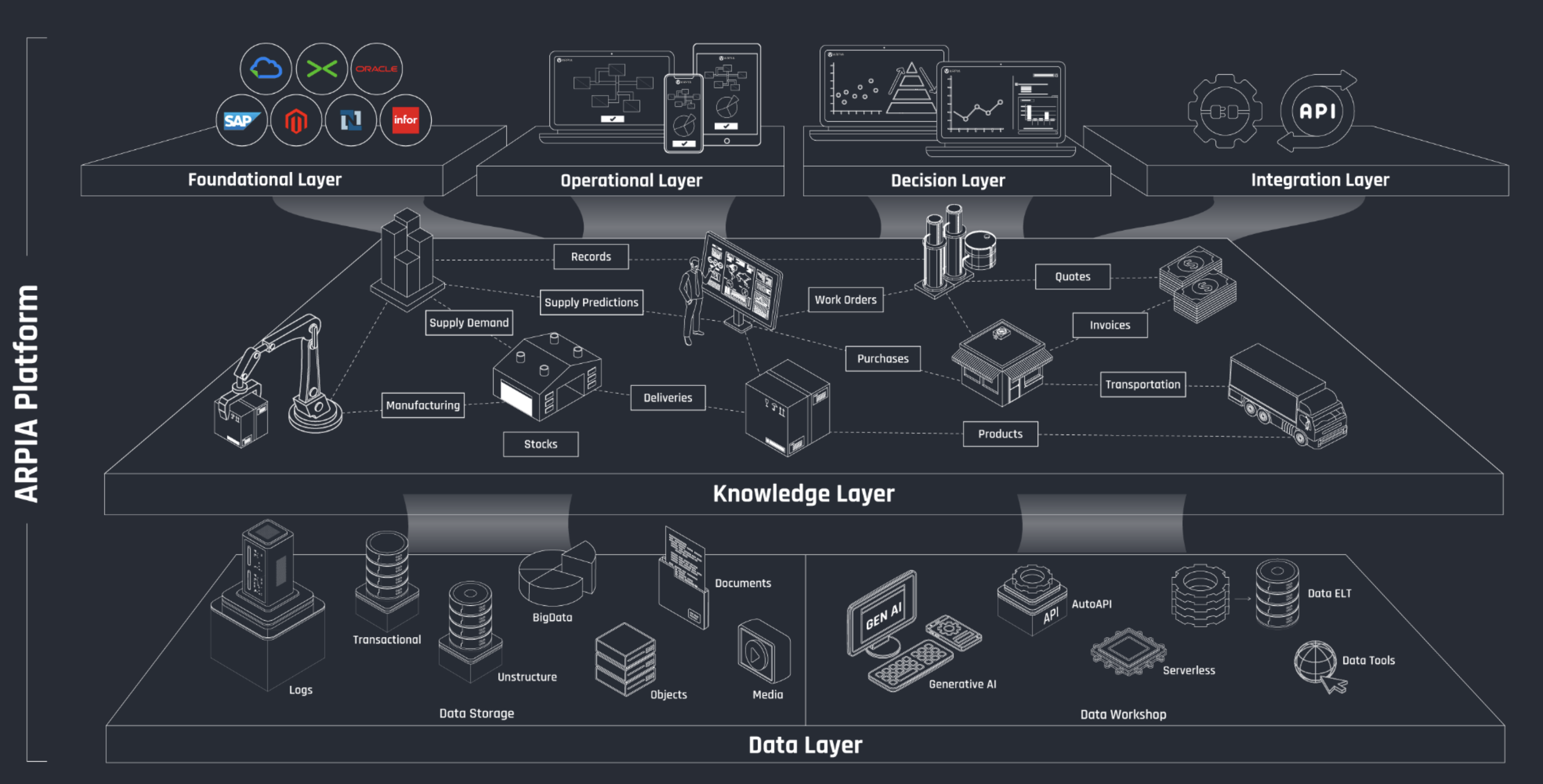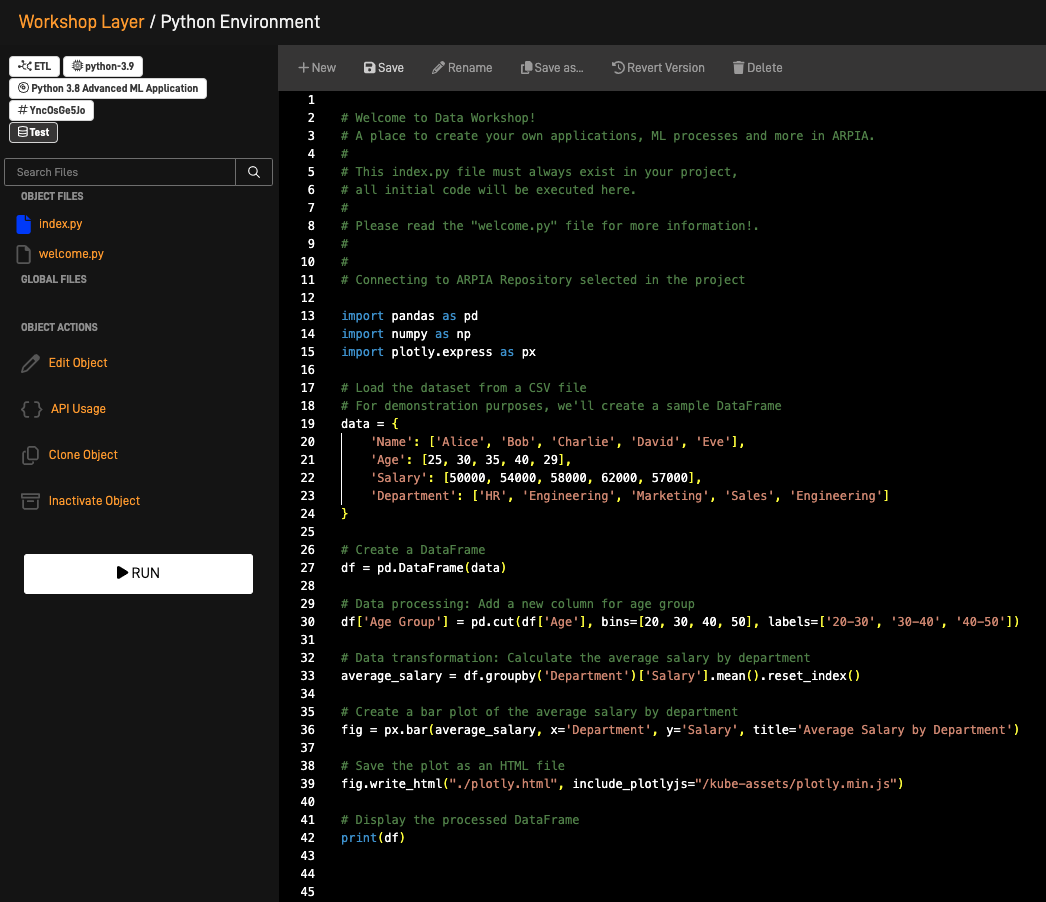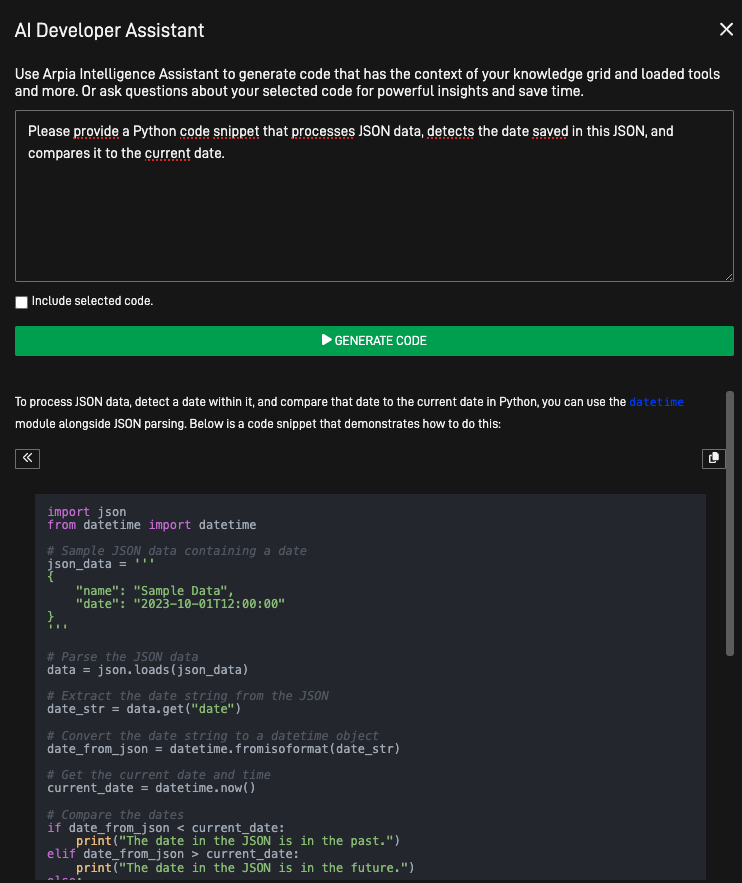AI Features in Arpia Intelligence Platform from A to Z
A detail description of how AI is used in all layers of the Arpia Platform from A to Z.
Arpia AI Platform: In-Depth Guide to AI Capabilities and Data Flow
Welcome to the Arpia AI Platform documentation. This guide follows the natural data lifecycle within an organization, showcasing how Arpia’s layers integrate to enable streamlined, AI-driven workflows. From data ingestion to decision-making, Arpia’s platform empowers organizations with an organized, optimized digital twin through its Knowledge Grid, facilitating real-time insights, governance, and operational intelligence.

The data flow within Arpia starts with AutoAPI, enabling seamless data ingestion and integration from various external sources into the Arpia ecosystem.
Key Functionalities
-
- Arpia’s datapipes enable continuous data ingestion from CRM systems, IoT devices, ERP systems, etc., feeding directly into the platform's digital twin in real-time.
-
Bidirectional Data Flow:
- Supports two-way data synchronization, allowing Arpia to ingest data from external systems and push processed data or insights back, ensuring operational harmony.
-
Ingestion Workflows with LLM Integration:
- AutoAPI workflows can connect with the LLM Workshop Object, unifying AI and ML workflows to prepare and transform data for analysis.
This ingestion layer forms the backbone of Arpia's data ecosystem, ensuring a steady flow of high-quality, real-time data.
The Knowledge Grid is Arpia’s core data governance layer, acting as an intelligent digital twin that organizes and optimizes data for AI-driven insights and operational intelligence.

Key Capabilities
-
Digital Twin for Data Governance:
- Provides a centralized digital representation of the organization’s data. Each Knowledge Node is a meta-representation (or data model) for categories like customers, transactions, or assets, facilitating data mapping, governance, and regulation.
-
AI-Driven Node Management:
- Users can control data interactions with AI-driven tools, fine-tuning temperature settings for AI responses, specifying vector and embedding columns, and setting query result limits.
-
Semantic Embedding for Real-Time Insights:
- Enables efficient context-aware data queries, supporting deep insights through semantic search and embedding functionalities.
The Knowledge Grid ensures organized data flow, optimizing AI models and enhancing downstream applications, such as real-time decision support.
Once ingested and organized, data undergoes transformation and AI processing within Arpia’s Data Layer and Workshop environments.

Workshop and Data Layer Capabilities
-
Workshop Concept:
- Users can build isolated workflows with Docker environments for Python and PHP, enabling advanced data manipulation and preparation for AI applications.
-
AutoML Object:
- Leverages AutoGluon for training models on historical data, supporting image and time series data to predict real-time outcomes.
-
Workflow LLM Object:
- Semantic Search: Uses vector embeddings from models like Jina, Llama3, OpenAI, and Claude.
- LLM Generative AI: Creates structured insights and new data points.
- Generative AI for Compatible Queries: Converts inputs into structured queries, stored as JSON for efficient data flow.
The Data Layer and Workshop streamline AI-driven data preparation and insights extraction, delivering operational intelligence to downstream applications.
The DataApps Studio transforms AI insights into actionable intelligence, enabling direct data interaction within operational interfaces.

Key Features
-
Assistant-Driven Decision Support:
- Arpia’s AI assistants extract insights and provide actionable data for decision-makers, generating predictions based on organizational goals.
-
Visualization Tools:
- Leverages Arpia’s graphing tools to create charts, dashboards, and maps, helping users interpret complex data quickly.
-
Conditional Logic for Interactive Workflows:
- Supports conditional logic in LLM Generative AI steps, enabling workflows to adapt dynamically based on user inputs and ensuring precise, relevant insights.
DataApps Studio empowers organizations to leverage real-time insights for strategic and operational alignment.
The Workshop Layer includes a full-featured IDE for custom code development, enabling advanced AI-driven capabilities for data scientists and developers.

Key Capabilities
-
Python and PHP IDE with Preloaded ML Libraries:
- Equipped with TensorFlow, PyTorch, and other ML libraries for efficient data manipulation.
-
SQL Query Editors:
- Direct access to data repositories for granular-level SQL queries.
-
AI-Assisted Coding:
- Translates natural language (Spanish, English) into code, using metadata from the Knowledge Grid to simplify
The Workshop Layer includes a full-featured IDE for custom code development, enabling advanced AI-driven capabilities for data scientists and developers.

The final layer connects Arpia’s insights back to external systems, creating a continuous feedback loop.
Key Features
-
Real-Time Data Pipes for External Integration:
- Enables bi-directional data flow, allowing insights to be streamed back into external systems for synchronized data.
-
Virtual Tables:
- Allows external applications to access processed insights directly, facilitating rapid AI-driven insights in operational environments.
This layer ensures Arpia’s insights are leveraged in real-time across external systems, enhancing operational efficiency.
Conclusion
The Arpia AI Platform redefines AI adoption, offering structured data governance, AI modeling, and bi-directional data flow. The Knowledge Grid acts as an organized, optimized digital twin, empowering organizations to seamlessly harness AI for predictive analytics, decision support, and continuous data pipelines.
Arpia provides the tools, flexibility, and intelligence necessary to drive impactful AI integration across your organization.
Updated about 1 year ago
